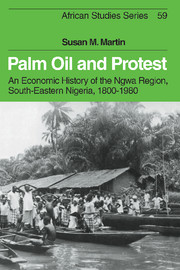Book contents
- Frontmatter
- Contents
- List of maps and figure
- Acknowledgements
- Abbreviations
- 1 Introduction
- 2 Ecology, society and economic change to 1891
- 3 The Ngwa and colonial rule, 1891–1914
- 4 The expansion of the oil palm industry, 1884–1914
- 5 The end of the boom
- 6 Cassava and Christianity
- 7 Authority, justice and property rights
- 8 Trade, credit and mobility
- 9 Production and protest: the Women Riot, 1929
- 10 Cash cropping and economic change, 1930–80
- 11 Conclusion
- Statistical appendix
- Notes
- Interviews conducted in the Ngwa region, 1980–1
- Bibliography
- Index
- Frontmatter
- Contents
- List of maps and figure
- Acknowledgements
- Abbreviations
- 1 Introduction
- 2 Ecology, society and economic change to 1891
- 3 The Ngwa and colonial rule, 1891–1914
- 4 The expansion of the oil palm industry, 1884–1914
- 5 The end of the boom
- 6 Cassava and Christianity
- 7 Authority, justice and property rights
- 8 Trade, credit and mobility
- 9 Production and protest: the Women Riot, 1929
- 10 Cash cropping and economic change, 1930–80
- 11 Conclusion
- Statistical appendix
- Notes
- Interviews conducted in the Ngwa region, 1980–1
- Bibliography
- Index
Summary
This book has its origins in a desire to shed light on the problems of poverty and agrarian change in contemporary Africa. In the course of writing it, a further aim developed: that of reconstructing Ngwa economic history in a way that reflects the perceptions and experiences both of farmers and of officials. While the latter aim dictated the structure of the main narrative chapters, the desire to explore the wider implications of the Ngwa experience remained, and will be reflected in the analysis below. The Ngwa case study will be shown to have two major implications. Firstly, it demonstrates that the current ‘food crisis’ cannot be explained in all cases as the outcome of ‘underdevelopment’. In the Ngwa case, the limitations and ultimate failure of export-led rural development require analysis of a different kind from that needed to explain the current decline in soil fertility and food production. Secondly, the regional comparisons made in this study show that the impact upon farmers of falling cash incomes and food supply problems can vary regionally, socially and over time; similar variations can be found in farmers' strategies for dealing with these problems. An appreciation of the origins of different strategies is essential for all who wish to imitate or modify them.
Within dependency and vent-for-surplus theory, changes within the export sector are held to set the pace of changes outside it. Within Ngwa economic history, the expansion of export production certainly preceded the onset of serious shortages of staple foods. For both these reasons, this concluding survey will begin with an exploration of export sector history and will then examine the causes of recent changes in the Ngwa domestic economy.
- Type
- Chapter
- Information
- Palm Oil and ProtestAn Economic History of the Ngwa Region, South-Eastern Nigeria, 1800–1980, pp. 137 - 143Publisher: Cambridge University PressPrint publication year: 1988

